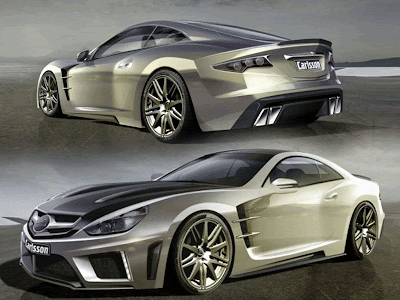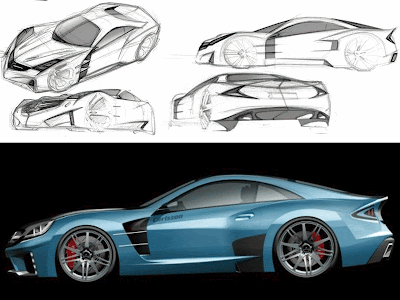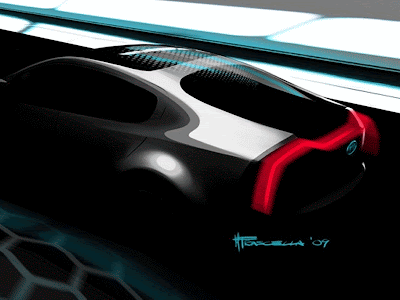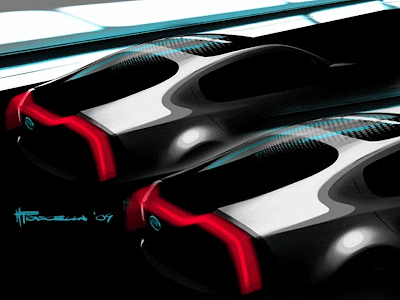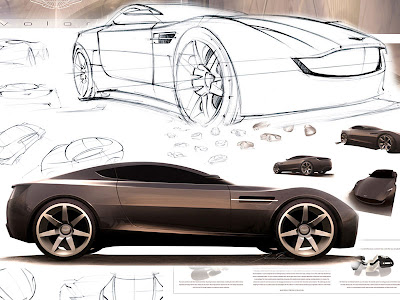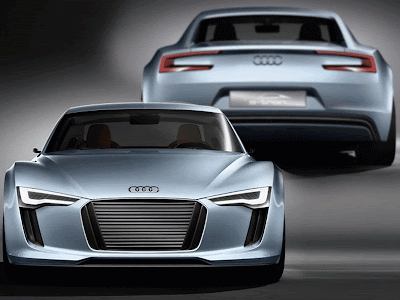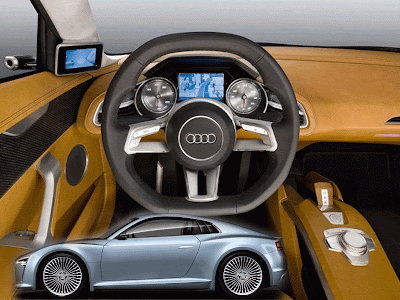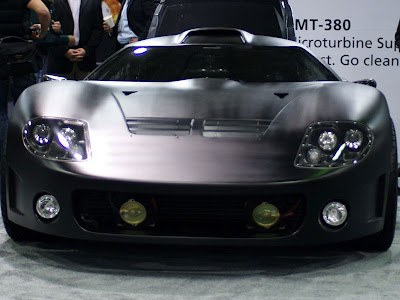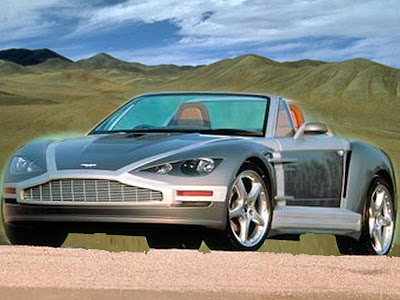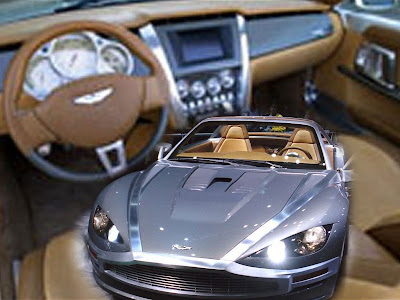Showing posts with label Concept Car. Show all posts
Showing posts with label Concept Car. Show all posts
The company is now branching out a bit, and turning their sites on the sub-€15,000 Daihatsu Materia. German tuners Inden-Design is better known for their work on high-priced models from Ferrari and Mercedes. Dubbed the "Icecube," the bright white box has been outfitted with a host of new items. On the exterior, the new body kit contains four different extensions that can be attached over the current panels, as well as a daytime lights, and a new rear bumper with diffuser. Triangle-shaped side mirrors and carbon fiber door handles and boot cover are also installed.
The Inden-Design Tuner has modified the new ICECUBE cars both from optical and from the technical point of view at the same time. This resulted in the creation of the rough look. The Daihatsu ICECUBE Materia creates a convincing outfit by innovative design and exemplary functionality at a car tuning level. The whole kit consists of an extension set (four extensions (of 10 parts) for 448,00 Euro without mounting and putting at the vehicle), a rear bumper with diffuser (448 Euro) and the standard front bumper fascia equipments with day drive lights (230 Euro) in the front turn signal housing. Further identification features are triangular mirrors outside, door handles and a boot lid cover of real carbon (1,200 Euro for the set).
The rear and has been equipped with high-grade steel exhaust system and a catalyst converter with two polished end pipes for 1,198 Euro, which produce the corresponding sound for the optics. The car handling of the ICECUBE becomes with H&R sport helical differential gear (780 Euro) even more sporty. due to the sport differential gear, maximum traction at all road conditions and therefore, of course an optimal behavior on the road will also be reached.
In addition, the rear end has been equipped with high-grade steel exhaust system and a catalyst converter with two polished end pipes for 1,198 Euro, which produce the corresponding sound for the optics. The car handling of the „ICECUBE" becomes with H&R-sport helical differential gear (780 Euro) even more sporty. Due to the sport differential gear, maximum traction at all road conditions and therefore, of course, an optimal behavior on the road will also be reached.
But something has been positively changed from within as well. Many options in the interior like triangular mirrors, the central console, the door switch covering, the entrances and the B-column with real carbon in silver (1,450 Euro) are just some of a lot of features, making the life in the ICECUBE sportier. In addition, the speedometer shaft, the A-column and the door armrest have been trimmed with alcantara (680 Euro). There is also a high-quality loudspeaker system (1,200 Euro) with high frequency loudspeaker on front and rear doors - finally, a Phillips DVD-monitor incl. navigation system (1,298 Euro) demonstrates that this baby knows what`s what. The sporty pretensions are connected here with individuality, without discarding ordinariness at the same time.
Finally, moving to the interior you will find a new central console, door switch covering, and the entrances around the B-column lined with real carbon fiber in a silver color. Along with all theses improvements, owners of the Daihatsu Materia can order the speedometer shaft, alcantara trimmed door armrests, a high quality loudspeaker system, and lastly a Phillips DVD monitor system including navigation. The complete package from Inden-Design for the Daihatsu Materia ICECUBE costs 19,784 euros.
Labels: 2010, Concept Car, Daihatsu, Design Car, Tuning
LAMPO2 is an electric demonstration sports car conceived by Protoscar, a Swiss company which has been developing CleanCar projects for 23 years including consulting of OEMs, power utilities and governments. The LAMPO2 boasts 'quick-charging' capability (up to 100 km range extension in just 10 minutes charging time) and will be presented at the Geneva Motor Show (2nd March 2010) on the e'mobile stand Nr. 5141.
2010 LAMPO2 Electric Sports Car Protoscar Concept
LAMPO2 is an even more energy efficient successor to the LAMPO demonstration vehicle presented in 2009. Weight, aerodynamics and the efficiency of individual components of the BRUSA drive train have been further optimized in order to reach a world-class energy consumption of less than 100Wh/km-ton under real conditions. LAMPO2 is equipped with 4 different charging modes:
• standard single-phase with up to 3,3kW on board charger for typical overnight home-charge,
• 'control-pilot' equipped and (EDF provided) PLC single-phase with 6,6kW on board charger typical for public charging,
2010 LAMPO2 Electric Sports Car Protoscar Concept
• standard three-phase 9,9kW on board charger typical for charging at industrial plugs (fleet-owners) and
• an interface for DC fast charging (able to transmit a max. power of 80kW), where up to 100km of additional range can be charged within just 10 minutes, by an off-board system, so that the different solutions can be compared in terms of usability and efficiency by being demonstrated in real conditions.
2010 LAMPO2 Electric Sports Car Protoscar Concept
LAMPO2 will be shown together with different charging infrastructure solutions: a smart home charge device (developed with ALPIQ), the public charging station E-TOTEM and the quick-charging station (developed with ABB and Brusa).
2010 LAMPO2 Electric Sports Car Protoscar Concept
LAMPO2 impressively demonstrates that electric drive-trains are mature and perform sufficiently well to be a solution for all types of vehicles, not just city cars. This includes premium cars, the segment through which most new technologies have successfully been introduced into the market.
2010 LAMPO2 Electric Sports Car Protoscar Concept
Together with the first LAMPO (which has already been driven over 10'000 km on race tracks and public roads across Europe), LAMPO2 will be used for practical demonstrations and testing. Protoscar has repeatedly been encouraged to develop an advanced electric cabriolet for small-scale production and plans to use the LAMPO2 to evaluate this possibility. The evaluation will include discussions with potential industrial and financial partners, and an assessment of the preferences and desires of potential clients. Lampo crossing the Gotthard pass in May 2009.
2010 LAMPO2 Electric Sports Car Protoscar Concept
In addition to BRUSA, which supplies the components of the whole drive train, the main partners and sponsors of the LAMPO2 project are ALPIQ (the leading Swiss company in power generation and distribution, which is actively promoting the goal of 15% of electric vehicles in Switzerland by 2020), the German Fraunhofer Institute IAO (EV-specific features and MMI, as well as optimization of the ergonomics), ABB (DC fast-charging technology) and the Swiss Federal Office of Energy.
2010 LAMPO2 Electric Sports Car Protoscar Concept
Technical details LAMPO2 has two electric motors (allowing it to operate as a four-wheel drive with variable torque between front and rear axle for optimal handling, safety and efficiency) with a total output of 260 kW (equivalent to 350 HP), 600 Nm (50% more than its predecessor!) and over 30 kWh of Lithium-Ion battery capacity. LAMPO2 features real sports-car performances: 5 seconds to accelerate from 0 to 100 km/h, 200 km/h of max. speed and a range of over 200 km. More than enough energy for driving is produced by a remote solar plant which is installed on the roof of a farm in Tuscany, allowing a real zero-emission drive on a 'Well-to-Wheel' basis.
Source - Protoscar
Labels: 2010, Concept Car, Sports Car
Maserati Electric Supercar Tramontane Concept
The Maserati Tramontane Concept is a luxury electric supercar with a futuristic design characterized by flowing elements that form different layers and interconnect the exterior and the interior. The author is Czech design student Ondrej Jirec.
The Maserati Tramontane is a lightweight electric luxury supercar with an original design focused on the reduction of the total number of body parts and the simplification of the production process by combining exterior and interior elements.
Maserati Electric Supercar Tramontane Concept
Aside from the slippery, aerodynamic overall shape, the most eye-catching aspect of the concept's design is the number of components and body panels which flow from the interior to the exterior. These body parts have different functions, color, material and characteristics which are designed to add different dimensions and effect the overall feel of the vehicle.
Maserati Electric Supercar Tramontane Concept
It was created by Czech student Ondrej Jirec for his Alias class at the Art Center College of Design. Among the distinctive features of the Maserati Tramontane's design are the components and body panels which flow from the interior to the exterior. These parts have different function, color, material and characteristics and create layers that add different "dimensions" and define an original design language.
The first layer is the main glass exterior surface that essentially envelops the entire car. It is supported by a black frame which attaches to the chassis.
Maserati Electric Supercar Tramontane Concept
The second layer is composed of the headlamps and the dashboard. This single piece carries the LED headlights and flows smoothly back into the interior where it protects the speakers and interior air vents.
The third layer of the Tramontane creates the lower sections of the seats and, as it reaches the exterior, also carries the taillights. This particular part possesses very high resistance to impact. In case of side impact the seat and chassis work together to protect the occupants. But in the event of a rear collision, this part contains a crumple zone that will collapse, so the seats remain protected.
Maserati Electric Supercar Tramontane Concept
The fourth layer, placed in the front, serves as a housing for the electric motor and also as a dashboard. This element is attached to the chassis and hides the motor, frame, and all the electronics.
Having its length at 4,250mm, Tramontane is just 50mm shorter in length to Lamborghini Gallardo. Its height is 1,170mm which is almost the same as that of Gallardo’s. Its front wheels are driven by an electric motor, whereas the rear ones have an electric motor for each.
Maserati Electric Supercar Tramontane Concept
The most striking facet of its design is the number of components and body panels that smoothly move from interior to the exterior. Its parts have different functions, color, material and characteristics that aid more to the overall feel of the vehicle.
The proposed drivetrain for the concept is an all-electric setup. The front wheels are driven by one electric motor, while the rear wheels each get their own motor.
Labels: Concept Car, Electric Car, Maserati, Sports Car
2010 Carlsson C25 Super-GT Concept
At the 2010 Geneva Motor Show the German tuning firm Carlsson, who unsurprisingly specialize in modding Mercedes-Benz models, will unveil the C25 - an insanely aggressive 753 horsepower monster.
2010 Carlsson C25 Super-GT Concept
Carlsson C25 is the first self-developed automobile from Carlsson and are presenting C25 at Geneva Auto Show this March. The concept of this Super-GT is based on the vision of combining maximum driving performance with an entirely new design and high exclusiveness. The result is a breathtaking and beautiful sports coupé with 753 hp in a limited edition of only 25 cars world-wide. Thereby, each automobile will be as individual as its future owner.
2010 Carlsson C25 Super-GT Concept
Carlsson presents an own developed automobile at this year’s Geneva Motor Show – the Carlsson C25 Limited Super-GT. The concept of this Super-GT is based on the vision of combining maximum driving performance with an entirely new design and high exclusiveness. The result is a breathtaking and beautiful sports coupé with 753 hp in a limited edition of only 25 cars world-wide.
2010 Carlsson C25 Super-GT Concept
The performance data of the six litre V12 Bi-Turbo is impressive. The high-performance aggregate with a motor management optimisation patented by Carlsson renders 753 hp (554 kW) and allows fast acceleration as well as smooth travels at lower speeds. Also responsible for the perfect performance evolvement is the elaborately developed stainless steel exhaust system with ends in four edgy pipes at the back. The power catapults the C25 with a torque of 1320 Newton metres at 3750 r.p.m. which is electronically limited to 1,150 Newton metres from 0 to 100 km/h in only 3.7 seconds and achieves a maximum speed of 352 km/h.
2010 Carlsson C25 Super-GT Concept
The Carlsson C25 Super-GT Concept also comes with an ultra-light and forged wheels 1/10 UL in the dimensions 9,5×20 and 12×20 inches have been especially designed for the C25 and are equipped with high performance tyres measuring 265/30 at the front and 325/25 at the rear live axle.
Labels: 2010, Carlsson, Concept Car, Sports Car
Kia Ray Hybrid Concept
KIA Motors is currently preparing their new concept car that will be displayed at the Chicago Auto Show 2010. The figure in the vehicle named Kia Ray in the form of the official release has a unique taillights.
Kia Ray Hybrid Concept
Kia Ray Hybrid Concept Kia Ray is the vehicle plug-in hybrid that is a picture of Kia's green programs in the future. Platform concept would seem hibryd used Kia models that will come, but it is unlikely that vehicles will be the Kia design language that will come.
Kia Ray Hybrid Concept
Kia Ray designed at Kia's American design studios released only in an illustration. There's no other details about this vehicle and it seems we must wait until the Chicago Auto Show going to get any further to what is really shown by Kia through Ray Plug-in hybrid it.
Kia Ray Hybrid Concept
But most likely, will carry the Kia Ray drive system similar to that used by Kia Blue-will. We will wait.
Labels: Concept Car, Kia
Aston Martin Volare is an eco-friendly
The Aston Martin Volare is a proposal for a next-generation Aston Martin supercar which features an environmentally friendly drivetrain. Aston Martin, like all other supercar manufacturers, faces a dilemma over the next decade; How to dramatically reduce the carbon footprint of their vehicles while also maintaining performance levels which are equal, or superior, to past models.
Volare The Aston Martin Sports Car Concept
The Aston Martin Volare is a design study of a two-seater sportscar that combines the typical styling cues of the brand with a fuel-cell powertrain and an interior characterized by the use of eco-friendly materials. The author is Coventry graduate James Trim. The two-seater Aston Martin Volare Concept features a high-power fuel cell stack, located between the front seats, a rear mounted battery pack, and a co-axial electric motor at the front. To aid the Volare’s weight distribution, the two hydrogen storage tanks have been positioned directly above the car’s rear axle. The Aston Martin Volare concept was a vehicle developed by James Trim during his final year at Coventry University studying Automotive Design. He is currently looking for placement opportunities.
Volare The Aston Martin Sports Car Concept
Speaking about the exterior design of the concept, James Trim explains, "The underlying aim when designing the Volare was to combine present day technologies with the profile of a car that would be instantaneously recognisable as that of an Aston Martin."
Trim said of the design; “Aesthetically the vehicle sharpens up the familiar Aston Martin proportions, with much crisper shoulders and a noticeable ‘floating’ rear deck. The solid front grille was inspired by the older V8 Vantage, while the flexible front fenders can alter their shape to reveal daytime running lights or full headlamps.”
Volare The Aston Martin Sports Car Concept
The interior uses eco-friendly leather. The materials used in the tanning process are derived from sustainable, farm bred, Mimosa trees. The natural extract from the trees is used to produce the chemicals necessary for farming leather.
This results in an enironmentally-friendly natural process, producing breathable and highly flexible hides. The center console is made from recycled aluminium. The emerging binnacle and Bang & Olufsen twin lens speakers add a touch of theatre to the cabin. "The principle concern being confronted by Aston Martin is the harmful impact their cars are having on the environment. With this in mind, the Aston Martin Volare retains the fantastic sound and outright performance customary with that of a gasoline equivalent.
Volare The Aston Martin Sports Car Concept
Side from the eco-friendly drivetrain, another dictating factor in the Volare’s design was the desire to create a car which was instantly recognizable as an Aston Martin. It was important that the styling was influenced more by the heritage of the brand, rather than the source of power. On the Volare concept all the hallmarks of Aston Martin are instantly apparent, sleek profile, short front and rear overhangs, trademark grille, powerful rear arches and uncluttered lines.
Labels: Aston Martin, Concept Car, Sports Car
2010 Audi e-tron Sports Car Concept
The Detroit Audi e-tron Concept is 3.93 meter (154.72 in) long and 1.78 meter (70.08 in) wide but just 1.22 meter (48.03 in) tall two-seater; just a few months after the debut of the Audi e-tron Concept at the 2009 Frankfurt Motor Show, this is now the second electric concept vehicle from the brand with the four rings. Audi is showing an uncompromising purist compact sports car with all-electric drive at the 2010 NAIAS. Lithium-ion batteries, located for an optimal center of gravity behind the passenger compartment and ahead of the rear axle, make an effective energy content of 45 kilowatt-hours available. This makes an operating range of up to 250 kilometers (155.34 miles) realistically possible.
2010 Audi e-tron Sports Car Concept
Coupled with the Detroit Audi e-tron Concept's low gross weight of around only 1,350 kilograms (2976.24 lb), high-torque power units driving the rear wheels guarantee commensurate road performance. Two electric motors with a combined output of 150 kW (204 hp) and 2,650 Nm (1954.54 lb-ft) accelerate the coupe with ASF-design aluminum body from 0 to 100 km/h (62.14 mph) in just 5.9 seconds. The Audi e-tron Concept accomplishes the sprint from 60 to 120 km/h (37.28 - 74.56 mph) in a mere 5.1 seconds.
As previously with the first Audi e-tron Concept car shown in Frankfurt, Audi again bases all components in this electric vehicle on an integral concept with many revolutionary details: a heat pump as an efficient means of heating up and maintaining the interior temperature. The drive system, power electronics and battery have innovative thermal management - crucial for maintaining a high operating range coupled with outstanding interior comfort.
2010 Audi e-tron Sports Car Concept
The two electric motors, which have their own cooling system, are mounted on the rear axle. This special package, featuring a 40:60 weight distribution, ensures perfect balance, which contributes to the driving dynamics of the Audi e-tron Concept.
The trapeze of the single-frame grille dominates the distinctly wedge-shaped front end and is flanked by two large air intakes. The top of the grille merges into the flat strips of the adaptive matrix beam headlight modules with their clear glass covers. All light units use ultra-efficient LED technology.
One design element that is specific to electric vehicles developed by Audi - such as the Audi e-tron - are the air intakes in the single-frame grille and behind the side windows on the C-post. They are closed flush under normal circumstances and opened by retracting slats when additional cooling air is required. The slats above the drive unit then also open to provide a better through-flow of air. These measures, too, maximize efficiency - the concept car is outstanding for an already low drag coefficient that is further improved when the flaps are closed.
2010 Audi e-tron Sports Car Concept
The combination of aluminum and carbon fiber-reinforced composite material guarantees supreme rigidity coupled with low weight. Audi will soon use this technology in a similar form for future production vehicles. Despite the complex drive system layout with two electric motors and a high-capacity battery system, the total weight of the Audi e-tron Concept on display in Detroit is only around 1,350 kilograms (2,976.24 lb).
The MMI is controlled via a scroll pad with a touch-sensitive surface on the steering wheel ("MMI touch") - an element inspired by modern smartphones. The steering wheel itself is clearly flattened off at both the top and bottom, in a clear reference to motor sport.
A smartphone that can be integrated into the front section of the center console interfaces between the vehicle, the driver and external information sources. The driver can use a suitably equipped conventional smartphone as a car phone, address database, navigation system and video player. At the same time they can also use it as an operating unit for many specific on-board systems in the Audi e-tron Concept. Many phones that are suitable for these functions are already available from various manufacturers.
2010 Audi e-tron Sports Car Concept
Characteristic for the concept of the Audi e-tron - and therefore also characteristic for a further development in an electric vehicle - is the near total elimination of switches and small components such as the ignition. The climate control unit is located to the right above the steering wheel. The display provides temperature and ventilation information. Again drawing inspiration from a smartphone, the system is controlled by means of a touch-sensitive sliding control.
Labels: 2010, Audi, Concept Car, Sports Car
Capstone Supercar CMT-380 the high performance hybrid electric microturbine vehicle Debut at LA Auto Show
The Capstone CMT-380 was the surprise basement find of the LA Auto Show.The Capstone CMT-380 is essentially a prototype show car designed to highlight the technology and products available from Capstone Turbine Corporation. The concept for the high performance hybrid electric microturbine vehicle was developed by Electronic Arts (EA) Chief Creative Director Richard Hilleman.
After working on the car for four years, inventor Richard Hilleman was the man of the hour as he fielded questions about his unusual microturbine-lithium-ion hybrid powertrain fitted to a GTM Supercar kit body. It may still be in the test phase, but Capstone claims that the car can reach a top speed of 150mph, and is able to sprint from zero to 60mph in just 3.9 seconds.
The CMT-380 features an unusual hybrid drivetrain which uses one of Capstone's new C30 (30-kilowatt) microturbine engines to extend the range of the primarily electric powered vehicle. The turbine can be run on either diesel or biodiesel.
The CMT-380 features lithium-polymer battery cells that can be charged at home or at a public recharging station. While driving, the CMT-380 can operate on 100 percent battery power in zero emissions mode for a range of up to 80 miles. When the batteries reach a predetermined state of discharge, the Capstone C30 microturbine quietly fires up and recharges the batteries on the fly to extend the driving range up to 500 miles. The diesel fueled C30 microturbine requires less maintenance than traditional combustion engines and produces ultra-low exhaust emissions. Hilleman has owned an electric vehicle – a converted Porsche 550 Spyder – for at 15 years and has constantly upgraded it. The EV used to have just 30 hp with lead acids but now uses lithium ferrous batteries and has 200 hp. The 100-mile range hasn't changed, though, and so he knew it was time to build a hybrid. He decided on Capstone's diesel microturbines as the range extender.
He knew he could rely on them – they've been used in buses for years – but there was still the challenge of fitting the unit into a car like this. Hilleman built the CMT-380 just for himself, but Capstone is happy to show it off as a proof of concept vehicle. It would be too pricey to put into mass production (Hilleman estimated he put in about $375,000 hours of work), but it's not impossible that a high-end, expensive, limited production run could be made some day.
Right now, Hilleman is really happy with his creation. He especially loves the sound of the vehicle. Three feet to the side of the car, the microturbine puts out about 87 dB, but in the cabin, it's nearly silent. California law might require him to add a muffler, but it's already quiet enough without one. He's got a solution for that problem, should he need it.
The chassis and bodywork of the Capstone CMT-380 are borrowed from the Factory Five GTM kit sports car, and modified to accept the hybrid drivetrain.
"Capstone's CMT-380 is just now finishing up the conceptual design and first article testing stage," said Darren Jamison, Capstone President and CEO. "We plan to finalize very soon a limited production plan, in part, based on interest received at the [2009] LA Auto Show. We anticipate customers will be a select group of individuals who appreciate its many innovative high-performance and high-technology driving characteristics, long driving range and ultra-low emissions," added Jamison.
The CMT-380 features lithium-polymer battery cells that can be charged at home or at a public recharging station. While driving, the CMT-380 can operate on 100 percent battery power in zero emissions mode for a range of up to 80 miles. When the batteries reach a predetermined state of discharge, the Capstone C30 microturbine quietly fires up and recharges the batteries on the fly to extend the driving range up to 500 miles. The diesel fueled C30 microturbine requires less maintenance than traditional combustion engines and produces ultra-low exhaust emissions. Hilleman has owned an electric vehicle – a converted Porsche 550 Spyder – for at 15 years and has constantly upgraded it. The EV used to have just 30 hp with lead acids but now uses lithium ferrous batteries and has 200 hp. The 100-mile range hasn't changed, though, and so he knew it was time to build a hybrid. He decided on Capstone's diesel microturbines as the range extender.
He knew he could rely on them – they've been used in buses for years – but there was still the challenge of fitting the unit into a car like this. Hilleman built the CMT-380 just for himself, but Capstone is happy to show it off as a proof of concept vehicle. It would be too pricey to put into mass production (Hilleman estimated he put in about $375,000 hours of work), but it's not impossible that a high-end, expensive, limited production run could be made some day.
Right now, Hilleman is really happy with his creation. He especially loves the sound of the vehicle. Three feet to the side of the car, the microturbine puts out about 87 dB, but in the cabin, it's nearly silent. California law might require him to add a muffler, but it's already quiet enough without one. He's got a solution for that problem, should he need it.
The chassis and bodywork of the Capstone CMT-380 are borrowed from the Factory Five GTM kit sports car, and modified to accept the hybrid drivetrain.
"Capstone's CMT-380 is just now finishing up the conceptual design and first article testing stage," said Darren Jamison, Capstone President and CEO. "We plan to finalize very soon a limited production plan, in part, based on interest received at the [2009] LA Auto Show. We anticipate customers will be a select group of individuals who appreciate its many innovative high-performance and high-technology driving characteristics, long driving range and ultra-low emissions," added Jamison.
Labels: 2009, Capstone CMT, Concept Car, Sports Car, Supercars
2020 Aston Martin Twenty Twenty Sports Car concept designed by Giorgetto and Fabrizio Giugiaro of ItalDesign (2001)
Geneva is one of the world's great auto shows, if for no other reason than it's the place where Italy's design houses and coachbuilders -carrozzerie- annually roll out their latest concept cars. This year, Aston Martin previewed the production version its voluptuous Vanquish (covered elsewhere in this issue). But that wasn't the only Aston on the show floor. The Aston Martin Twenty Twenty concept from 2001 was designed by Giorgetto and Fabrizio Giugiaro of ItalDesign.
The fully-functioning concept car was intended as a vision for a convertible Aston Martin sports car for the year 2020. Italdesign sprung this amazing car on the unsuspecting visitors to the 2001 Geneva Salon L'Auto. This startling car, based on an early production DB7 Vantage, has a body shape made of exposed extruded aluminium structural elements; body panels made from plastic and carbon fibre are fitted onto it. Thankfully Aston Martin’s current styling trend is headed in a completely different direction to the Twenty Twenty concept.
The brushed aluminium highlighting lines which adorn the Aston Martin Twenty Twenty are an original design feature. However their overuse (especially around the front) gives the concept an unusual, almost comical appearance from some angles. The grille surround almost looks like lipstick.
The Twenty Twenty is powered by front mounted, uprated version of the 6 litre V12 from the DB7 Vantage, said to produce 500bhp - visible through a grilled fairing on the bonnet. Initially it appears to be a strict 2 seater, although the rear bulkhead can be removed to provide seating for two children. The rear of the Aston Martin Twenty Twenty (from the doors back) is more appealing with more conservative use of bare aluminium. The soft top is stored in its own special housing that can be slotted into position between the roll-bar and the windscreen, 'Targa' fashion. Notice the fantastic door hinges - derived from the classic Aston wing vent, are both decorative and functional elements.
Giorgetto Giugiaro and Aston Martin previously co-operated in 1961, when Carrozzeria Bertone worked on the two-seater DB4GT Jet coupe prototype. And like the original 'Jet' car, the 2020 is destined to remain unique. Aston Martin are believed to have thought the 2020 'interesting', but no plans were ever made even for limited production. As the Twenty Twenty isn't an official Aston Martin design project, don't look for any sort of production version. What about the name? Simple: It's the term commonly used to describe perfect vision. And the Giugiaros clearly have good eyes.
In March 2004, I received an e-mail claiming the 2020 was for sale, but I have been unable to find any reference to this anywhere. But the car was seen for the first time in the UK at the Goodwood Festival of Speed, June 2005.
Labels: Aston Martin, Concept Car, Sports Car, V12
Subscribe to:
Posts (Atom)




















